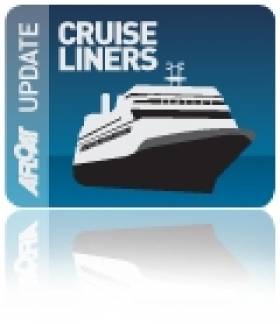Displaying items by tag: 4th Cancelled Cruisecall
#AnotherCancellation– Another cruiseship has cancelled a call to Dun Laoghaire Harbour in favour of Dublin Port, bringing to four in total on what was to be a record season of 22 callers for the south Dublin Bay port, writes Jehan Ashmore.
The giant 142,000 tonnes Royal Princess with a 3,600 passenger capacity will not be making its originally scheduled call tomorrow (5th June) according to the Dun Laoghaire Harbour Company.
Instead the cancellation of the 330m (1,083ft) Royal Princess will see the Italian built ship dock in Dublin Port in the early hours of tomorrow morning. This will be her second visit to the capital port having previously cancelled an anchorage call off Dun Laoghaire only last month.
Of the 22 calls originally scheduled for Dun Laoghaire, four have cancelled, two have made visits so far (both at anchor) requiring passengers be tendered ashore. This leaves 16 cruise calls (4 to berth in harbour) remaining throughout the season ending in September.
The double successive cancellations of Royal Princess within a fortnight has further reduced Dun Laoghaire's record season of 22 cruise calls. Should however all 18 calls in total be achieved this will still be a record season for the Dun Laoghaire Harbour Company which restored the business in recent years given the backdrop of the declining ferry service to Wales which closed last year.
Conflicting schedules however surround the Princess Cruises operated ship which according to the Dublin Port Company website is to see Royal Princess make another call on 29 June, the same day she is scheduled to visit off Dun Laoghaire Harbour.
Royal Princess is scheduled to be the most frequent caller to Dun Laoghaire this season with a total of 9 calls, despite two of these calls cancelled. She is expected to make six more calls.
The French built cruiseship has only made a single anchorage call off Dun Laoghaire Harbour on 12 May, a day after MSC Splendida cancelled an inaugural opening season call off the south Dublin Bay port.
The 3,100 passenger MSC Splendida subsequently cancelled a second call in May to Dun Laoghaire but switched to Dublin Port to make a repeat astern 'reverse' docking call, (see report).
MSC Cruises cited their decision to use Dublin Port rather than anchor off Dun Laoghaire Harbour was due to the positive passenger feedback been so close to the capital, allowing more time to spend ashore. Interestingly, the MSC Splendida will after all be calling to Dun Laoghaire Harbour as Afloat.ie has confirmed she is finally to make her maiden call offshore on 29 August.
Another reason for the change of decision according to DLHC was that MSC Splendida choose Dublin Port to avail of the high-tide and berth alongside Alexandra Basin West, where a proposed €30m double-cruise berth terminal is to be located close to the East-Link bridge.
The proposed terminal would enable Dublin Port to accommodate the largest cruise ships in the world, Royal Caribbean International (RCI) 'Oasis' class of a whopping 225,000 plus gross tonnes. These behemoths of the seas can carry almost 5,000 passengers and are 362m length overall (LOA).
At the same time Dun Laoghaire Harbour Company proposed €18m single cruise-berth would permit considerably larger cruiseships than present to berth within the harbour and avoid having to currently tender passengers ashore. Both proposed projects would require a dredging programme to allow such deeper-draft cruiseships to berth in port.
The Dun Laoghaire cruise-berth is designed for cruiseships such as RCI's 'Freedom' class of some 154,000 tonnes and at 340 (LOA), though DHPC cite that cruiseships slightly longer could also be accommodated.























